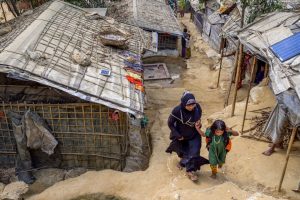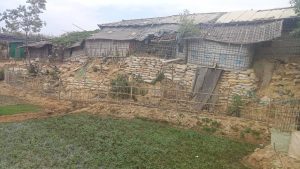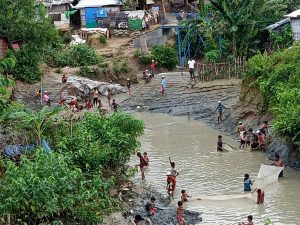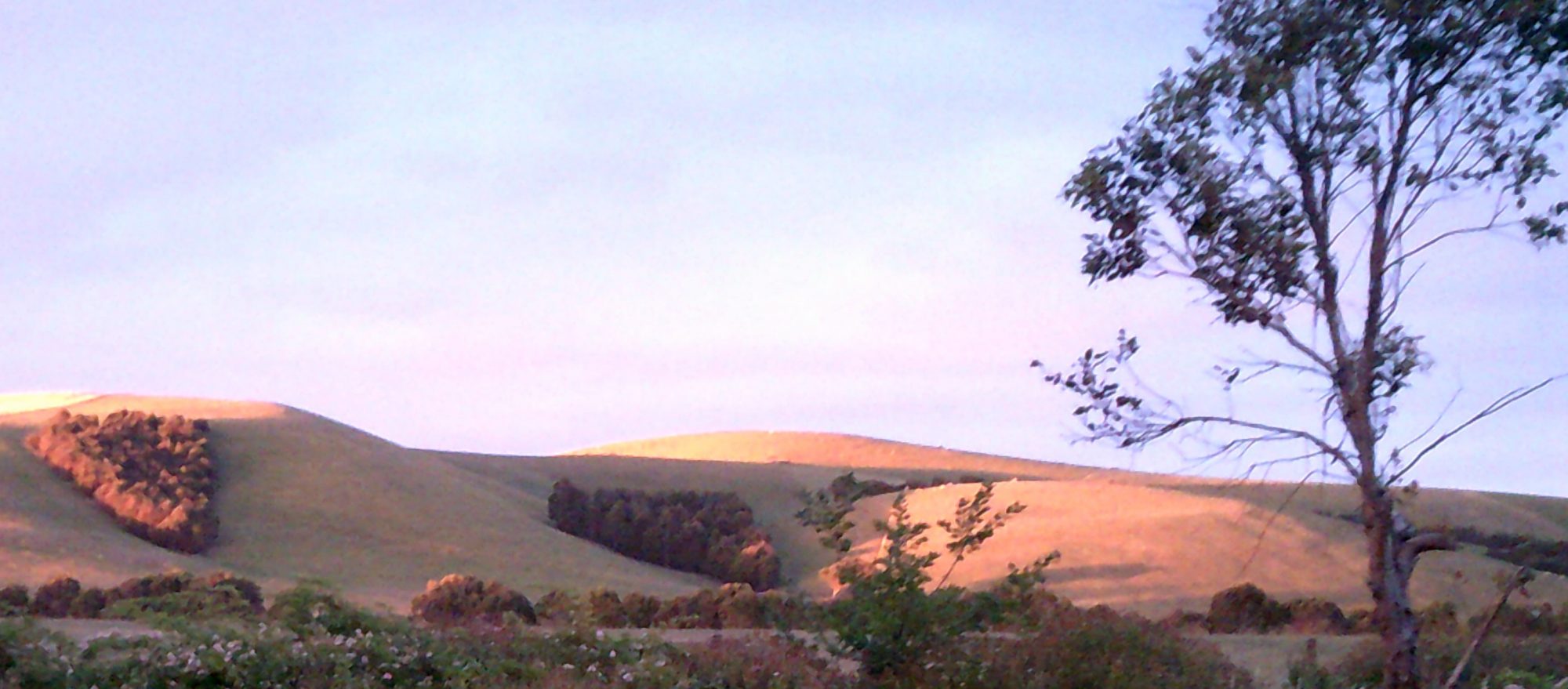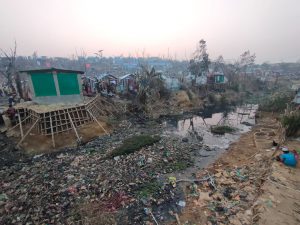The Case for Abolishing Closed Refugee Camps.
Dr Chris James (Australia).
Images by Nsrs Rohimullah.
Abstract.
In a world plagued by wars and natural disasters, we need to think about how we deal with the growing number of refugees and displaced persons. Currently these people are incarcerated in closed camps with dangerous, unsanitary and inhumane conditions. The following paper argues in favor of the abolition of all closed refugee camps and the urgent need to resettle the world’s stateless people. We need to re-examine the efficacy of the current refugee system, and look for new options. For the purpose of this debate the focus is on the world’s largest refugee camp, the Kutupalong Camp in Bangladesh, which houses the Rohingya refugees.
Introduction.
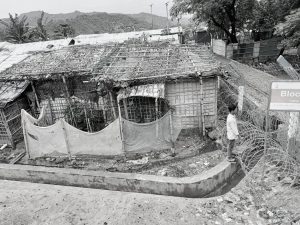 Shelters at Kutupalong.
Shelters at Kutupalong.
Kutupalong in Context.
In Kutupalong there is a desperate need for resettlement, or the safe return of its residents to their homeland. Some of the Rohingya refugees have been in the camp for more than 30 years. For decades now, the Rohingya, an ethnic Muslim minority group in Myanmar, a predominantly Buddhist country, have faced institutionalised discrimination, such as the denial of their basic Human Rights and citizenship. The Myanmar government launched a full-blown military campaign in 2017 that forced seven hundred thousand Rohingya to flee. Rights groups have accused the government of a genocide against the Rohingya people, but the government of Myanmar deny the accusations. Almost a million refugees fleeing the violence are now living in the Bangladesh camp. With such a large number of people occupying one place, and now a second and third generation in situ, the lives of these refugees are becoming untenable. The shelter is insufficient for keeping warm in winter or cool in the summer months. The buildings are made of plastic sheeting and bamboo sticks that are not strong enough to withstand the rough weather. The camp is over-crowded, which has implications for health. Human waste is left exposed and the landscape, with is soft earth hills is particularly unsafe for residents and their children. In 2022 a small child was buried alive, one of many incidents. Added to these extremities, there are chronic shortages of fresh drinking water. The annual monsoon rains bring further misery with huge floods and regular landslides making the area an environmental disaster. In essence, the camp is no longer viable as it does not meet the standards set out by the United Nations High Commission for Refugees (UNHCR).
In the Kutapalong camp, families are undernourished, physically restrained and psychologically tormented with what has been described as consistent racial discrimination. Residents are intimidated, harassed, beaten and deprived of their basic needs. The refugees have no freedom of movement, they are treated like prisoners and they have committed no crime. Humanitarian AID is dwindling and as the cost of living rises worldwide, Kutupalong and other camps like it are becoming untenable.
The Bangladesh Government have made one attempt to relocate the Kutapulong residents to the silt island of Bhasan Char, in the Bay of Bengal. In 2020 the Bangladesh authorities were asked to remove 300 Rohingya refugees, including children and return them to the mainland as they were being held without freedom of movement, adequate access to food and medical care.[i] The refugees in Kutupalong are there because they fled the Rohingya genocide. Now many are feeling as though they are experiencing another form of genocide, the inhumane treatment that diminishes their will to survive. Host countries that take on the responsibility for housing refugees predominately fall into the impoverished or developing world category. Animosity is already present in the population when the poor are asked to make evermore sacrifices. Neither the host nations, nor the refugees can continue to sustain this arrangement. Another solution is desperately needed.
Safety Issues in Kutupalong.
The following pictures illustrate the instability of the landscape. The floods and landslides make the environment particularly unsafe for children and the elderly, they are unpleasant and a health risk for everyone.
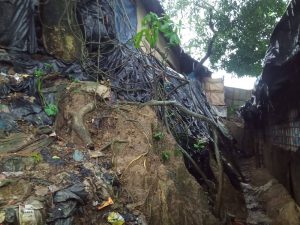 Landslide at Kutupalong.
Landslide at Kutupalong.
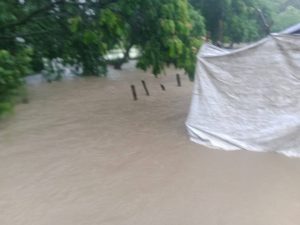 Water at dangerous levels.
Water at dangerous levels.
Perceptions:
Countless thousands suffer. They drown while trying to cross the Mediterranean Sea. They die in the Sahara Desert. They die trying to cross into Mexico. They are kidnapped and sold into slavery. They die at home because they are too poor to attempt escape. With no foreseeable end to the flow of refugees determined to reach wealthy countries, where voters are growing less rather than more willing to welcome them, more tragedy is assured. (Conor Friedersdorf, The Atlantic).
Citizens in some European countries estimate the number of migrants at three or four times more than they actually are. The global volume of refugees and migrants as a percentage of the global population has actually remained relatively stable for several decades, at around 3% of the world’s population. Contrary to some perceptions that refugees rush to wealthy nations, 85% of refugees globally are hosted in developing countries. [ii]
Every few years the issue of refugees and their plight comes to fore and embeds itself into the west’s popular culture where perceptions are often distorted. For example, there is a common fear that among refugee populations there are terrorists able to cause harm when resettled in other host countries. There is absolutely no evidence to suggest this is true. There is also the perception that refugees will stay on welfare payments at the cost of the western taxpayer. This too, is totally untrue. Refugees have been found to be hard working and very enterprising. Refugees do not threaten a nation’s culture, they add to it and the majority of citizens made refugees welcome. In almost all cases, countries have benefited from refugee settlement. Nonetheless, over the years an anti-refugee movement has taken hold in many western countries, largely fueled by Right-Wing conservative despots with their own political agendas. There is no foundation to any of the claims made by these groups. The west will not be swamped by Asians or undermined by religious zealots, no one should pander to this scare-mongering. Fortunately, like everything else in popular culture, claims and counter-claims can fade from public attention. Notwithstanding, not too many people want their communities flooded with refugees. As journalist Conor Friedersdorf remarks,
“these refugees spark political controversy wherever they arrive in large numbers. For that reason, governments in Europe, North America, and Oceania have differed on how many refugees they are willing to resettle. Even Germany’s leader Angela Merkel, who helped make Germany the Western country with the biggest population of recent refugees, found that the public’s openness was quickly exhausted.”[iii]
The facts cannot be denied. Public opinion can be negative and it drives the agendas of politicians worldwide who must, in turn appease their voters; so we end up with cruel and inhumane policies that have no real foundation in truth and that benefit no one. The time has come when we must get to the core of what seems to be an intractable problem. Refugees have Rights under International Law that are being ignored. Moreover, refugees are entitled to a secure and reasonable standard of living. Currently, refugees are destitute and living in extreme hardship, a situation that will impact on generations to come. We must act now; the need is urgent.
What can be done? We may not stop the wars and skirmishes or the natural disasters that give rise to the flow of refugees, but we can change the way the refugee system works. The current system is broken and it is causing untold misery to all concerned. The refugee system was meant to ease the pain of displacement and keep people safe. Refugee camps are not safe, they are not desirable and they are an added burden to the already impoverished countries that accommodate them. Refugee camps are overflowing with displaced people with no hope of a normal life unless we act to change the system.
Migration.
Resettlement is one of three solutions UNHCR is mandated to implement in cooperation with countries that have signed the 1951 Refugee Convention. The other two options are the local integration of refugees (in the country of refuge) and voluntary repatriation (return to one’s home country). UNHCR will only consider resettlement if the other two options are not available. In effect, the UNHCR sponsors very view refugees for resettlement, and most refugees must find the money for visas and be able to support themselves for two years, this adds up to roughly $17,000 US per person. First, they must secure permission from UNHCR and the government of the host nation before they can apply for a visa and leave the camp.
Not every refugee will be eligible for resettlement. The seven categories (or criteria) used by UNHCR to select refugees for resettlement include:
- Legal and/or Physical Protection Needsof the refugee in the country of refuge (this includes a threat of refoulement/return to danger).
- Survivors of Torture and/or Violence, where repatriation or the conditions of asylum could result in further traumatization and/or heightened risk, or where appropriate treatment is not available
- Medical Needs, in particular life-saving treatment that is unavailable in the country of refuge
- Women and Girls at Risk, who have protection problems particular to their gender
- Family Reunification, when resettlement is the only means to reunite refugee family members who, owing to refugee flight or displacement, are separated by borders or entire continents
- Children and Adolescents at Risk, where a best interests determination supports resettlement, and
- Lack of Foreseeable Alternative Durable Solutions, which generally is relevant only when other solutions are not feasible in the foreseeable future, when resettlement can be used strategically, and/or when it can open possibilities for comprehensive solutions. [iv]
These are undoubtedly admirable goals, but they are not the reality of what is taking place.
Australia takes very few refugees compared to other countries and it does not always take refugees recommended by the UN agency.
Though the UNHCR recommends or refers people for resettlement, the ultimate decision to grant a visa will rest with Country’s Immigration Department. Australia has four offshore refugee category visas: Refugee (visa subclass 200); In‐Country Special Humanitarian (visa subclass 201); Emergency Rescue (visa subclass 203); and Woman at Risk (visa subclass 204). Applications for an Australian refugee category visa (whether self-referred or referred by UNHCR) must be made on the prescribed form which is available from Australian overseas missions and from the Department’s website. Applicants are expected to provide as much documentation as possible (including certified copies) at the time of application to assist in identity verification. The application must be lodged outside Australia at an Australian diplomatic or trade mission and will be processed at designated Australian missions around the world. Unsuccessful applicants receive a letter indicating that one or more of the legal criteria have not been met. Though there is no mechanism to appeal an adverse decision, unsuccessful applicants may re-apply. [v]
Refugees seeking to enter Australia on a Refugee visa (subclass 200) must satisfy numerous criteria that are more onerous than onshore Protection visas. For instance, in addition to being subject to persecution and meeting health, character and national security requirements, the Minister must be satisfied that there are ‘compelling reasons for giving special consideration to granting the visa’ having regard to:
the degree or severity of persecution to which they are subject
the extent of their connection with Australia
whether another country can provide for the applicant’s settlement and protection from persecution and
the capacity of the Australian community to provide for their permanent settlement. [vi]
Also, the Minister must be satisfied that their permanent settlement would be the appropriate course for the applicant and would not be contrary to the interests of Australia. Moreover, the visa grant must be consistent with ‘the regional and global priorities of the Commonwealth in relation to the settlement of persons in Australia on humanitarian grounds. In other words, there must be a visa available under the Humanitarian Program for the given program year.[vii] Other Commonwealth countries have similar criteria.
The country that has helped refugees the most is Turkey, home to almost 3.7 million refugees. Other significant host countries for refugees are Pakistan (1.4 million), Uganda (1.2 million), Sudan (1.1 million), Iran (979,435) and Lebanon (949,666). (Figures for 2018).[viii] The number of refugees Australia accepts has varied in recent years. Australia accepted and resettled 12,706 refugees in 2018. [ix] According to the Red Cross, that figure jumped to 18,200 in 2019.[x] During the Morrison Government between 2020-2021 the number fell to 4,558 refugees [xi] and the policy of processing asylum seekers offshore and treating them as illegal was tightened. Clearly, the number of refugees Australia has been willing to take pales against other significantly poorer nations.
Around the world in 2020, 1.1 million new claims for asylum were lodged with governments or through UNHCR. Australia reported that during the 2019-2020 financial year, 23,266 claims were made within Australia, and 70,621 from outside of Australia. The 2022 the incoming Labor Government adopted the same cruel policy towards asylum seekers, leaving them housed in draconian conditions and unable to pursue their Rights. Juxtaposed to this gross violation of Human Rights the Australian population are led to believe that the nation has one of the most generous refugee responses in the world. The UNHCR’s official statistics tell us a different story.
While the world is facing a refugee crisis, there are distinct actions that could be taken to ease the burden:
- Give the refugees money in cash: Refugees have lost everything and they cannot start a life without money. It has been shown time and time again that when people have money they spend it, they invest in the economy, whereby one dollar spent in the marketplace can multiply to two dollars or more in the community.
- Education: Close to half of all refugee children, 48 per cent remain out of school. At primary level, the average gross enrollment rate for the year from March 2019 to March 2020 for reporting countries was 68%.[xii]
- Most refugee camps do not allow work. If families can support themselves then the burden on host countries and donors is significantly eased.
- Resettlement into communities. Refugees make active community members and add to a nation’s social capital.
- Keeping people healthy insures a healthy economy and a healthy community.
- When needs are met, both in the community and with respect to new arrivals there is no need for dissent.
Why have these initiatives not happened? Refugee issues are driven by politics and vested interests and there has been no political will to move forward with humanitarian solutions.
Refugees helping themselves.
While schools in the Kutupalong camp are officially closed, one of the initiatives taken by refugees in the camp is the creation of a Photography Studio. The camp has a very talented collection of photographers, some wanting to become professional. The photographers use social media to connect with the outside world and the outside world is finally getting a glimpse of how refugees are forced to live out their lives. Work from this studio has already drawn international attention.[xiii]

Children playing in the camp.
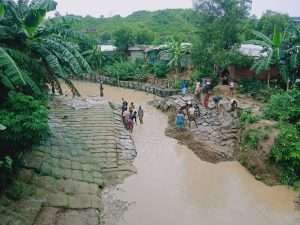
Holding back the land.
Those who manage to leave the camps never lose their identity as a refugee, they are damaged and stigmatized and generally in need of counseling or therapy. They face multiple difficulties, including discrimination. The Human Rights Council reports many complaints of racism.
Between 2016-2017 a report noted:
“Discrimination is the practical expression of prejudice. Prejudice, that is, beliefs and attitudes that rank some people as inferior to others or as inherently different from others, produces discriminatory actions. The two are intimately and inextricably connected.” [xiv]
We have seen discrimination against refugees played out in many ways. There are particular difficulties in housing refugees, sometimes due to ethnicity and sometimes due to large numbers. Recall the race riots in Britain in the 1960s and 1970s. Recall also the heated debates over the inclusion of Sharia Law into the British system. In this period, there were constant fears of an immigrant take-over of British culture. There were even more hostilities when Muslims wanted to build Islamic mosques and schools. The community protests often got ugly.
In 2005 there were a series of race riots on the beach front in the Sydney suburb of Cronella. The clashes started with a small number of agitators and then escalated over several suburbs. Riots in Europe were much worse. Australia, Britain and other western countries have a long history of racial prejudice so governments are reluctant to open borders. Even although there has not been a serious incident in Australia since 2005, borders remain closed to all but a very few.
In 2022 little has changed, discrimination against refugees is a major problem: The Human Rights Council point out just how damaging discrimination can be to a person’s health and well-being.
“The connection between personal identity and the proscribed grounds of discrimination is what makes discrimination so utterly unacceptable”.[xv]
The Council’s description goes on to suggest that
“it is not merely that a person is treated differently. It is that the basis for the detrimental treatment is the very nature of that person as a human being – who he or she is… It is not a matter of mere personal dislike. It is that the person suffering the discrimination is considered fundamentally different from, fundamentally inferior to the person imposing the discrimination. Discrimination involves one person’s rejection of another person as a full human being who is equal in dignity and rights to all other human beings. That is what makes discrimination a great evil. [xvi]
Added to this there has been a burgeoning Right-Wing movement connected to the One Nation Party and its stand against immigration. Mr Roland Jabbour who was the chairman of the Australian Arabic Council in 2005, a position he still holds, told the TV Channel SBS, “he wasn’t surprised” at the prevailing attitudes.
“There are many lessons (from the riots) and unfortunately, we have not really learned them and have not put them into practice. We tend to forget about these sorts of events and pretend that all is good…”Racism is well-entrenched (in Australia) … It’s an underlying issue in our community and all it takes is an incident, a certain trigger to bring this to the surface.” [xvii]
Attitudes have a profound effect of the resettlement of refugees.
In bringing about change, we must consider public reaction. There should be more education and further incentives put into the community to encourage multiculturalism. In addition:
- Discrimination laws should be tightened.
- Whole populations must stop glorifying wars.
- Governments must bring a halt to the arms race.
There is actually very little accurate knowledge about the history of refugees or the operations of refugee camps; their costs and their conditions would probably shock most people.
Segregation and Apartheid.
Once established, refugee camps divide their communities into systems of segregation, otherwise called apartheid. These systems are driven by fear and unwarranted constraints. Under apartheid people are closely scrutinized and life is strictly regulated with severe punishments for non-compliance. This has a deep psychological impact on the human psyche. The world has condemned apartheid in South Africa and in Israel’s hold over Palestine. It has been condemned in the treatment of African Americans as well as American Indians and Australia’s Aborigines, but few have been prepared to call out refugee camps as being a cruel and unforgiving system of apartheid.
Kutupalong covers 13 square kilometers in Cox’s Bazar, Bangladesh and it houses roughly one million people in a series of smaller locations (camps), each location is given a number. The camp is overseen by the United Nations High Commission for Refugees (UNHCR) and administered by local authorities, some of whom work in the camp. No one from outside is permitted to visit the camp unless they are visiting family or have special permission. No refugees are allowed to leave the camp unless they have a permit. Police constantly monitor the whereabouts of individuals and the behavior or the residents. People build their own shelters and infrastructure and they receive no payment for their work. Some refugees say they are made to carry out the jobs that staff are supposed to do and these are usually the dirtiest of tasks, like cleaning the overflowing toilets. Residents view this as a form of punishment.
Areas are fenced off with barbed wire and there are watch towers around the perimeter occupied by guards with rifles. The atmosphere in the camp is very intimidating and not unlike a high security prison, it is frightening and inhuman, but for refugees this is home. People die in these camps with no comfort and no dignity. Children live in these camps believing this is a normal way of life.
The UNHCR are committed to refugee self-reliance and advocate for some form of inclusion into the society of the host country, but this is not happening in closed refugee camps like Kutpulong. Preventing association among people or groups is psychologically damaging. The inability to acquire resources such as food, clean water, proper sanitation and more can fall under the unlawful act of genocide. Closure behind barbed wire fences constitutes imprisonment and is a violation of Human Rights. People are being held in arbitrary detention when these people have committed no offence.
Refugee camps were built for temporary stays not for a lifetime of punishment. The scenes are very disturbing, what is more disparaging is that people can advance in these groups, but only in as much as the constraints allow them to… and it needs to be said, that where there is institutionalized restraint there is usually some form of bribery and corruption.
Various reports have alleged that the refugees in Kutupalong have been harassed, intimated and put down due to their racial origins, but this is also played out in the distribution of services. Many medical needs have to be met by supporters outside. Health is a huge problem due to the conditions.
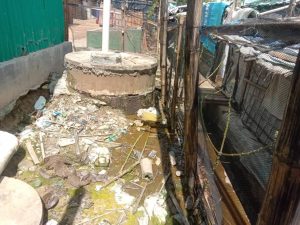 A flooding toilet next to a home shelter.
A flooding toilet next to a home shelter.
In Kutupalong the ablutions are a particular point of contention. Not only are they generally inadequate, they are made worse by deliberate neglect. (The structure of the toilets is basically that of a well, which is conducive to flooding). Refugees see this neglect as part of their punishment. Residents are judged inferior so they are left to do the dirty work.
As one resident commented, “These are the Rohingya shelters beside the toilet. The families who are sheltered beside the toilet have been facing a super challenge from these toilets for a long time. The toilets are dirty and faeces are getting out of the toilets. Can you imagine how the Rohingya are surviving refugee life?
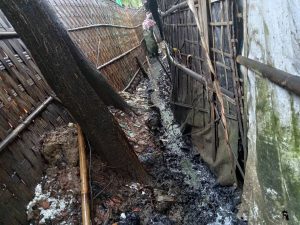 An old woman attempting to clean the drains.
An old woman attempting to clean the drains.
Ethnic tensions.
According to the UNHCR there are at least 89.3 million people around the world have been forced to flee their homes, almost all of them are Muslims. Among them are nearly 27.1 million refugees, around half of whom are under the age of 18. There are also millions of stateless people, who have been denied a nationality and lack access to basic services such as education, health care, employment and freedom of movement. Currently, 1 in every 88 people on this plant has been forced to flee their homeland.[xviii] 21.3 million people are under the United Nations Mandate. 53.2 million are internally displaced, 4.6 million are asylum seekers (who are also refugees) Children represent 30 per cent of the world’s population, but 41 per cent of all forcibly displaced people. More than two thirds (69 per cent) of all refugees and displaced abroad came from just five countries. 6.8 million come from the Syrian Arab Republic, 4.6 from Venezuela, 2,7 million from Afghanistan, 2.4 from South Sudan and 1.2 million from Myanmar.[xix]
Muslims make up the majority of refugees.
Why is it that almost all of the refugees are Muslims? Most recent civil wars have taken place in Muslim countries, and a large majority of the victims are Muslims. Most of these wars are also civil wars, which have attracted participation from the west. Undoubtedly, there is a battle within the Muslim world. However, the west has been greatly implicated in these wars, past and present, as all of these skirmishes have their roots in colonization. As a result, most of the Muslim countries continue to struggle with the arbitrary borders imposed during and after the colonial era. In addition, the Middle East is significant to the western economies, due to its location and the abundance of oil. Hence, the western nations have intervened in the wars to protect their own interests. This has scaled-up the levels of aggression and ultimately it has prolonged the fighting.
The United States (US) dominate roughly 15 percent of the world and the US economy is the largest and most productive in the world. The US accounts for one-fifth of global GDP with only 4 percent of the world’s population. America’s economy is nearly twice the size of China’s in nominal dollars. In addition, the US is one of just a few developed countries with a GDP that can bounce back after a crisis, this is largely due to its manufacturing and its export of goods and services. It is this trade that dominates the globe and leads the US to ensure that other nation’s leaders are US friendly. As a consequence, over the past 15 years, several military interventions have replaced relatively stable dictatorships with unstable semi-democracies where civil war still rages.[xx] As it happens, most Muslims do not live in war zones, yet Muslims carry the weight of blame for the world’s dilemmas.
Modern genocide in context.
After the European Holocaust, the international community vowed, “never again,” but despite this pledge, genocides and mass killings have continued to take place. The Early Warning Project at the United States Holocaust Memorial Museum tracks mass killings occurring today and attempts to predict where they might occur in the future. According to the project, an event is a mass killing.
“when the deliberate actions of armed groups, including, but not limited to, state security forces, rebel armies, and other militias, result in the deaths of at least 1,000 non-combatant civilians targeted as part of a specific group over a period of one year or less.”
Clearly, a lot of countries have been getting away with genocide. Under international law, a genocide occurs when the perpetrators intend to eradicate the group they are targeting. A mass killing does not require this intent. Thus, mass killing is a broader term than genocide, but acts of genocide also fall within this definition.[xxi] In fact, the world has taken a very soft approach to genocide because it is more likely to happen to poorer people who are often viewed as a burden to progress. The west failed to rescue the people of Barundi or Rwanda because they were not crucial to the capitalist order. Because people are poor, it does not mean they are unproductive or uneducated. The Rohingya people have had many great achievers, today and in history. The Rohingya were attacked because they are Muslims (albeit, a small number of Christians lived among them).
While confinement and genocides have their roots in ancient history, what we are seeing today is a distinctly modern problem with its origins in Europe. European history gives impetus to the existence of a rich and powerful Christian society, but in reality, there was a long history of Islam in Europe that dates back to the eighth century which has been largely forgotten.
Islam was established in the Balkans with the Ottoman conquest. In the 19th century many Muslims emigrated to Turkey from Europe. The Balkan Wars 1912-1913 displaced 800,000 people and at the start of the First World War they were officially called refugees. The modern definition of the international refugee status came about under the League of Nations in 1921 and the Commission for Refugees. Following World War II, a large number of people fled Eastern Europe and in 1951 the United Nations created the Refugee Convention and officially defined the term “refugee” (in Article 1.A.2). [xxii] This Article describes a refugee as any person…
Owing to well-founded fear of being persecuted for reasons of race, religion, nationality, membership of a particular social group or political opinion, is outside the country of his nationality and is unable or, owing to such fear, is unwilling to avail himself of the protection of that country; or who, not having a nationality and being outside the country of his former habitual residence as a result of such events, is unable or, owing to such fear, is unwilling to return to it. [xxiii]
Sadly, the western world has conveniently put the historical events aside, as a result, the world has become distinctly divided between Christians and Muslims. The divide is not just about religion, it is also about knowledge… Knowledge is power.
Islam was a highly advanced society during what has been called The Golden Age, and much of what Europeans lay claim to today, was allegedly borrowed from ancient Islamic teachers and scientists. We know this from the scientific details in the Qur’an and its additional scholarship. Historically, Islam created a great deal of fear in the minds of Europeans, especially in the European royal courts and grand houses. Much of that fear still exists today. Recall the disdain of the British Royal Family when Princess Diana wanted to marry a Muslim. Added to this, the Muslim countries have gathered renewed strength in recent years, they sit on assets the world needs for ongoing production, and the fears of a Muslim conquest have escalated to the degree that whole populations in countries like Australia are afraid of being, in the words of the One Nation Party, “swamped by Muslims” This discourse of fear is exacerbated by a lack of education as well as a lack of empathy for people in need. We can see some evidence of this fear and discrimination in the fact in the western world, people are willing to allow refugees from the Ukrainian war to stay in their homes, but others from Middle Eastern countries, Africa or Asia and the rest must suffer the indignity of unlivable and dangerous refugee camps.
Creating change.
The extremities of the refugee crisis are hard to fathom as the numbers grow exponentially, yet every year, the status and difficulties of these unfortunate people never changes because the UNHCR justifies the existence of camps using the rising costs of living in the outside world. Here is an example:
Reporting about refugees frequently shows aerial photos of tent cities, makeshift settlements and overcrowded camps. While this is the difficult reality for more than 6.2 million refugees, approximately 75 percent of refugees live outside of camps. Refugees living in cities, suburban and rural environments struggle to find safety and adequate shelter. Living conditions can be harsh, and lack basic services like electricity or heating. In addition to sub-standard housing, urban dwellings are often extremely expensive for refugees who left their home countries with little or no money and face difficult job prospects in their host nations. It’s easy to think that most refugees live in camps.[xxiv]
In light of the shocking conditions at Kutupalong, this argument just does not stand the test of credibility.
The political scientist Eric Kaufmann argues for a controversial alternative to camps in his recently published book, Whiteshift, a researched inquiry into how migration and demographic changes are affecting politics and culture in Western societies. Kaufmann argues that rather than settling refugees in western countries to live alongside citizens, who will not welcome them, he favours building permanent, closed refugee camps on western soil that accommodate anyone who wants to live there. Refugees would have the right to move to another refugee camp or to return to their home country, but would not have the right to enter the host country. Governments would draw a bright line distinguishing refugees from migrants.
There are two possibilities that could arise from Kaufmann’s proposition. One is this, if enough people chose to move into the new buildings, they would render the rest of the native population as the odd ones’ out… Alternatively, the new buildings could become a ghetto or another example of segregation and apartheid. My guess is, if the building were salubrious enough, and life was better for the refugees than their hosts, there would be a distinct shift in the dynamics, whereby those who vilified refugees might move to the new buildings and have a change of heart. Conversely, the natives might still resent the refugees.
The crucial message here is the need to build good standard housing for refugees and to work towards equality of opportunity. Also, camps should be situated in western countries, rather than in the developing world. My view is, they should be open not closed. People should have liberty regardless of any threats from dissenters, it is the task of the authorities to protect all people. In addition, the west needs to own its mistakes in the treatment of the developing world and stop exploiting people who are living in unstable nations. The west has an obligation to make up for its past and the harm it has caused generations of innocent people.
Asylum seekers.
Refugees are also called asylum seekers, but this group tend to arrive on shores undocumented and uninvited. Nations are still obligated to give asylum seekers refuge, but they have mostly ended up in detention centres offshore or deported back to where they came from. Kaufmann argues that widening the rights of asylum seekers is not a good option.
“Paradoxically, pressure to widen the rights of asylum seekers inside Europe makes it harder to fulfill the mission of getting people to safety. Why? Because if countries believe admitting refugees is the first step to granting permanent settlement, they will be more reluctant to allow them in. Claimants in the West have their cases judged increasingly harshly due to domestic political pressure to limit the number accepted for settlement. Those whose cases fail and cannot escape lack the option to remain safely in a high-quality facility. It’s estimated that thousands of genuine refugees are returned to countries where they risk being persecuted or killed.”[xxv]
Kaufmann believes nations should eliminate the incentive to provide refuge.
“Western publics are more likely to accept the financial burden of housing refugees on a long-term basis than accepting them as permanent settlers because they care more about the cultural impact of refugee settlement than the economic costs,” he argues. Absent cultural fears, burden-sharing among rich nations will be easier, he writes, as “countries will not be asked to alter their ethnic composition against their inhabitants’ wishes, only to contribute funds and build facilities.”
Kaufmann states:
“…to absorb any number of refugees without discriminating on the basis of wealth, fitness to travel and risk appetite,” as effectively happens now. “Nobody dies in transit or gets attacked or enslaved en-route.” And Western governments would have less need for gatekeeping bureaucrats. “This will offer refuge, but not settlement,” he notes, “so only those genuinely fearing for their lives will remain. There would be no need to engage in the impossible task of sorting genuine refugees from economic migrants”[xxvi]
Kaufmann concludes that hosting refugees in the West is a good litmus test of whether liberals are more interested in helping those in need or
“making the symbolic gesture of calling for more settlement, which is guaranteed to result in doors being closed.”
He writes,
“agitate to have camp residents resettled and call for facilities to be closed … We’ll revert to the status quo, in which many who flee war are sent back to die, unlucky migrants drown at sea or are preyed upon by criminals, the majority languish in underfunded camps and a small group of better-off risk-takers get lucky.”
He goes on to describe what he sees as the best version of the approach he favors:
“spacious permanent migrant centres across the full range of EU countries, alongside free transportation from conflict areas,” cutting deaths at sea, expanding refuge, and improving overall conditions among migrant facilities. “The optimal scenario is one in which every refugee can flee a conflict zone and be protected, housed, clothed, educated, and fed, receiving proper medical care,”
he writes.
“There should be recreational facilities and, ideally, an opportunity to work … This should be paid for by the international community, through either charities or contributions from wealthier countries.”
In Search of Dignity.
In 2016 the British General Secretary and Member of Parliament David Milbrand suggested closing all refugee camps. He said “they were designed for yesterday, not for today.” He thinks refugee camps should close in favour of wealthy nations accepting the most vulnerable 10% of the world’s 60 million refugees. Miliband thinks wealthy nations should also economically support poorer countries to help integrate new arrivals as full-time residents. If people need to move to a host country, then they should do so under a completely new deal. He states
“The new bargain is that a small number of people – probably up to 10% of refugees, the most vulnerable – are relocated to the richer countries to the west and elsewhere because of their medical needs because they’re orphans etc… [for] the large majority of people, the only real hope for them is to become productive residents of the countries that they’ve fled to.” [xxvii]
Miliband, who has led the US NGO the International Rescue Committee since 2013, said that the British public must accept refugees or suffer the consequences.
“Either refugees come to Europe in a disorderly, illegal and dangerous way, or they come to Europe in an orderly, legal and organized fashion.” [xxviii]
Miliband backed Angela Merkel’s policy of opening Germany’s doors to migrants. Miliband reiterates a common view that refugees need to get back to work, they need their lives back and they should be entitled to a happy future.
Kenya.
Kenya set the date for closing its Dadaab refugee camps in June 2022. The Dadaab camps were established 30 years ago to accommodate Somalis fleeing their country’s civil war. Now the government claims the camps are a home for terrorists, whereby donors have withdrawn their assistance.
According to MSF
“The planned closure of the camps in June 2022 should be an opportunity to accelerate the process of finding lasting solutions for refugees.” Ms Dana Krause, MSF’s country director in Kenya said “At present, the mostly Somali refugees in Dadaab, many of whom have been trapped in the camps for three decades, face dwindling humanitarian assistance and limited options for leading safe and dignified lives.”[xxix]
While Dadaab is no longer the largest refugee camp in the world, it is still home to approximately 232,903 refugees, many of whom were born in the camps and have known nothing else. Refugees in Dadaab are currently barred from working, traveling, or studying outside the camps, leaving them heavily dependent on humanitarian assistance. The Kenyan Government must now commit to giving these refugees the opportunity to study, work and re-train. These refugees have had their lives taken away and now they should be entitled to compensation; at least they need to get their freedom back with all the assistance they need to move forward.
Here is the reality, funding is likely to reduce regardless of whether camps close or not. In a world sitting on the prospect of more wars, famines and natural disasters, is it not more feasible to have a working, refugee population rather than keeping desperate people locked away and suffering? With the right will from the international community we could close the camps and use the available labour to boost economies and at the same time allow refugees to build their futures and those of their children. As Jeroen Matthys, project coordinator in Dagahaley, one of the three camps that make up Dadaab, said
“It is vital that refugees have uninterrupted access to humanitarian assistance throughout the camp closure process and until they have certainty about their future and can become self-reliant.”[xxx]
Giulia McPherson of Global News Migration and Displacement states:
In a recent visit to Kakuma, I saw clearly that refugees and partners are working together to find sustainable pathways for independence and inclusion. But many of these efforts have hit a critical roadblock. For example, access to primary and secondary education is readily available in Kenya, with 99% of refugees enrolled in primary school and 51% enrolled in secondary school. Yet many refugees who were able to graduate from secondary school remain idle, with no prospect for further education or employment. During my visit, I met dozens of young refugees with hopes of becoming entrepreneurs and teachers — like John, a 22-year-old from South Sudan who arrived in Kakuma when he was 4 years old. After completing secondary school, he searched for months for an opportunity to continue his studies. Finally, he enrolled in a Jesuit Refugee Service-sponsored digital literacy program that helped him master Adobe Photoshop. While John has dreams of becoming a graphic designer, he still lacks a computer, reliable access to the internet, and any job prospects… Investments in post-secondary and livelihoods programs are critical in helping refugees develop the skills they want and need to be independent, so that camps are no longer islands of solitude but instead thriving contributors to Kenyan society. These programs must not only provide access to training, but refugees deserve sustained mentoring and career counseling as they seek ways to put their skills to use.[xxxi]
It is a long road to making a difference, but we must make a start and never give up on the goals of bringing about equality of opportunity. We must close the camps and give refugees the opportunity to build a better life.
Conclusion.
In this paper I have attempted to make the case for abolishing all closed refugee camps. While this will not happen over-night, it is possible to begin the task of freeing refugees from their imprisonment. The outcome of the Kenya camp closure will be interesting to watch and it might surprise us.
There are many elements to this debate and I have only covered a few of them. The fundamental reasons for closing the camps are writ large in the 1951 Convention on Refugees, the camps are not providing protection, in fact, they are very dangerous places for adults and children. These are people who have lost everything and yet, they are being punished for their misfortune. There is no absolute solution, there have been many ideas, whereby everyone agrees there has to be a shift. All it takes is the first step on the path to take us to our destination.
Politicians have abrogated their responsibility in respect of the refugee crisis. Now is the time for change as public opinion is going against those who continue to promulgate the cruelty. As far as Australia is concerned, a new Labor government have simply adopted the untenable policies of the previous government, but their electorates could work against them. More people are rallying to the cause of freedom for refugees. More are becoming aware of the shocking conditions in the camps. Generally speaking, I believe most people are humanitarian in nature and they would like to see a humane solution to the refugee problem. I hope this paper will contribute to the debate and I pray for a better life for all refugees.
I wish to thank those people who have shared their refugee experiences with me. I wish to thank Nsr Rohimullah for allowing me to use his photographs. I wish good fortune to the Photography Studio at Kutupalong and I congratulate Mr Ziaul Haque for his constant hard work to bring the splendid talents of refugees to a wider audience.
I am finding my own engagement with refugees very rewarding. I have gained a lot of knowledge and insight into life in the camps and I thank everyone who has helped me. Thank you for giving me the privilege of representing you in this paper.
Dr Chris James June 2022.
_____________________________________________________
References:
[i] 300 people removed from Bhasan Char island; https://en.wikipedia.org/wiki/Rohingya_people – cite_note-303 Retrieved 25th June 2022.
[ii] The World Health Organisation. https://www.who.int/news-room/feature-stories/detail/10-things-to-know-about-the-health-of-refugees-and-migrants Retrieved 25th June 2022.
[iii] Conor Friedersdorf in the The Atlantic: June 12 2019. Retrieved 27th June. 2022.
[iv] Australian Parliament House. https://www.aph.gov.au/about_parliament/parliamentary_departments/parliamentary_library/pubs/rp/rp1617/refugeeresettlement#_Toc461022106 Retrieved 20th June 2022
[v] Ibid
[vi] Ibid
[vii] Ibid
[viii] Refugee Action Org. https://www.refugee-action.org.uk/about/facts-about-refugees/ Retrieved 20th June 2022.
[ix] Settlement Services International. https://www.ssi.org.au/faqs/refugee-faqs/141-how-many-refugees-does-australia-settle-each-year Retrieved 20th June 2022.
[x]The Red Cross https://www.redcross.org.au/act/help-refugees/refugee- Retrieved 20th June 2022 Refacts/#:~:text=In%202019%2C%20Australia%20resettled%2018%2C200%20refugees%20from%20overseas.
[xi] The Refugee Council. https://www.refugeecouncil.org.au/2018-global-trends/ Retrieved 20th June 2022.
[xii] UNHCR https://www.unhcr.org/en-au/education.html#:~:text=Close%20to%20half%20of%20all,
countries%20was%2068%20per%20cent. Retrieved 20th June 2022.
[xiii] Al Jazeera
[xiv] Ibid
[xv] Ibid.
[xvi] Ibid.
Nick Baker All it took was a trigger. Published 10 December 2020 at 5:57am Retrieved 20th June 2022.
SBS https://www.sbs.com.au/news/article/all-it-took-was-a-trigger-the-racism-of-the-cronulla-riots-15-years-on/rp4k54qfw Retrieved 21st June 2022.
[xviii] United Nations High Commission for Refugees UNHCR https://www.unhcr.org/en-au/figures-at-a-glance.html Retrieved 25th June 2022.
[xix] https://www.unhcr.org/refugee-statistics/ Retrieved 2022.
[xx] Nils Petter Gleditsch and Ida Rudolfsen. Are Muslim countries more violent. Washington Post May 16, 2016, Retrieved 29th June 2022.
Washington Post. https://www.washingtonpost.com/news/monkey-cage/wp/2016/05/16/are-muslim-countries-more-violent/ Retrieved 29th June 2022.
[xxi] Facing History Org. https://www.facinghistory.org/educator-resources/current-events/genocide-still-happens Retrieved 29th June 2022.
[xxii] FAQ: Who is a refugee? www.unhcr.org., Retrieved 22 June 2021.
[xxiii] Ibid.
[xxiv] https://www.unrefugees.org/news/myths-facts-where-do-refugees-live/ Retrieved 29th June 2022.
[xxv] Eric Kaufman (2019) Whiteshift and https://www.theatlantic.com/ideas/archive/2019/06/eric-kaufmann-closed-refugee-camp/589663/ Retrieved 29th June 2022.
[xxvi] Ibid
[xxvii] Steven Hopkins David Milbrand wants to close the world’s refugee camps. Huffington Post. Milbrand 14th May 2016. https://www.huffingtonpost.co.uk/entry/david-miliband-wants-to-close-the-worlds-refugee-camps_uk_57370134e4b0f0f53e36389e Retrieved 29th June 2022.
[xxviii] Ibid.
[xxix] Doctors Without Borders. https://www.doctorswithoutborders.org/latest/kenya-urgent-solutions-needed-refugees-dadaab-camps-close Retrieved 29th June 2022.
[xxx] Ibid.
[xxxi] Giulia McPherson of Global News Migration and Displacement states: Doctors Without Borders. https://www.doctorswithoutborders.org/latest/kenya-urgent-solutions-needed-refugees-dadaab-camps-close Retrieved 29th June 2022
